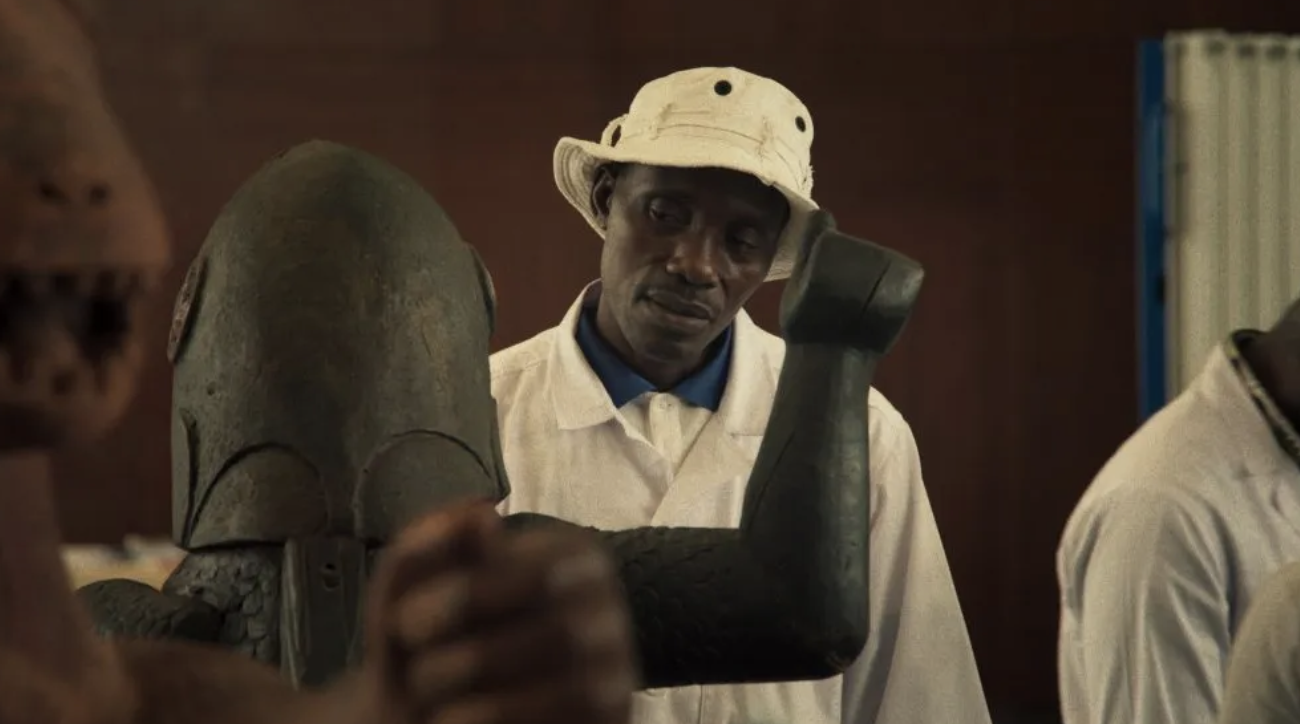When Europe’s great powers raced to colonize a continent in the so-called “Scramble for Africa” just before the First World War, the tiny coastal Kingdom of Dahomey in the south of modern-day Benin, west Africa, was high on France’s shopping list. Only 85 French soldiers were killed when it was taken in 1894, while as many as 4,000 Dahomeans lost their lives. Nearly three hundred years of culture and history were extinguished, and thousands of the nation’s most valuable treasures shipped to Paris.
Mati Diop’s 67-minute documentary isn’t about the theft but rather the return in late 2021 of 26 Dahomean treasures to Benin from the Musée du Quai Branly in Paris. We’re told before the movie starts that their “captivity” in France is finally coming to an end. That feels a little dramatic, but Diop means what she says. The most famous of the items, including a defiant statue of a warrior with his fist raised and a half-shark-half-man statue of Dahomey’s last proper ruler, King Behanzin, actually have voices. In dialogue written by the Haitian author Makenzy Orcel and voiced by Lucrece Hougebelo, Parfait Viayinon and Didier Sedoha Nassegande, they reflect on their return home as their careful transit is completed, baffled as they’re referred to by numbers rather than names in digitized, mystic-sounding voices that sound oddly similar to Transformers.
This unconventional choice is Diop’s way of saying that the artifacts are a living expression of a nation and its culture. To keep them in Paris is to deprive Benin of its past and, therefore, its present. After all, Africa’s national borders still line up more with decisions made during the Scramble than anything else.
Diop takes a side on this issue but is otherwise mostly a quiet observer. Most of the film‘s slight runtime is filled by the physical handling and moving of the artifacts and a discussion about the return at the University of Abomey-Calavi, in what was once Dahomey’s capital. Students express frustration that they can’t even speak the language of their descendants; French is Benin’s official language, but 54 more are spoken by the country’s 14 million people. Another points out that if it took 127 years for 26 of the estimated 7,000 items to be returned, it will be hundreds before they see any more.
This is Diop’s way of trying to indicate the state of opinion in Benin, but in truth students’ voices don’t really matter. Nor even Benin’s politicians. It was President Macron and the French parliament which decided to return the handful of items to Benin and Senegal, with Macron grandly telling an audience in Benin’s neighbor Burkina Faso in 2017 that “African heritage can’t just be in European private collections and museums”. Almost a dozen countries filed formal requests for the return of sacred items, with most still waiting. Britain’s museum leaders fear a slippery slope that could empty out entire museums. And in Berlin, where “Dahomey” is playing in competition, these themes will ring true: the city’s most famous artifact, the 3,000 year old Nefertiti Bust, was stolen from Egypt by the German Oriental Company.
Filmmakers reflecting on ceramics as a symbol of colonial happenings is not new: Diop has said that one of her only conscious influences was “Statues Also Die”, a 1953 film about looted African art in French museums directed by Alain Resnais, Chris Marker and Ghislain Cloquet. Parts of it are so critical of colonialism that it was banned in France. That film is thirty minutes long and “Dahomey” might have worked better at a runtime closer to that: the student debate, though well staged, becomes a bit repetitive, and some of the shots of boxes being loaded and unloaded go at a snail’s pace. The weight of history clearly weighs on “Dahomey”, and the fantastical elements need time and space, but a little more pace where possible would be no bad thing.
Diop has continued her exploration of post-colonial themes that feature prominently in “Atlantics” as well as the shorts and documentaries she made during a decade spent in Senegal, starting with 2009’s “Atlantique”. The ocean again features here as subtext: not as the alluring but dangerous method of travel as in “Atlantics”, but as a source of vulnerability exploited by the French colonizers. The presidential palace, where the artifacts are now displayed, now stands as a kind of coastal fort, its armory now restocked. For those who know little about the subject matter, “Dahomey” is a bold and memorable history lesson. But with Diop’s expressive talents as they are, it’s fair to hope that she returns to the world of fiction next time.
Grade: B
“Dahomey” premiered at the 2024 Berlin International Film Festival. It is currently seeking U.S. distribution.





